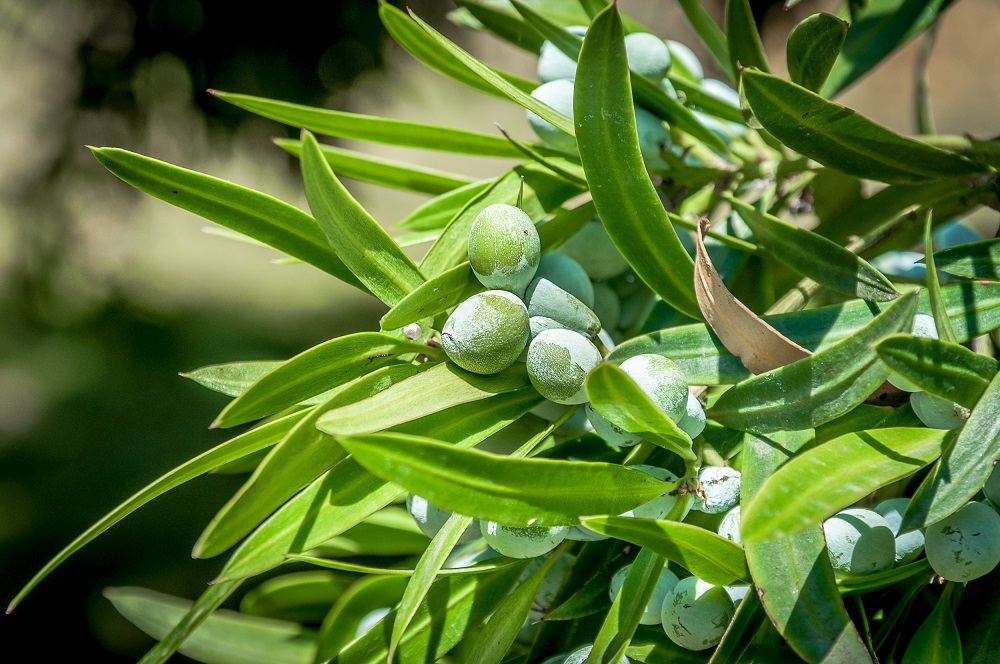Podocarpus
Common Name:
Buddhist pine, Chinese yew

General Information:
This upright, dense evergreen has pointed, leathery, dark green leaves arranged on stiff, symmetrical branches and works very well as a screen, hedge, strong accent plant, or framing tree. The crown forms a somewhat pyramidal to oval outline. Able to reach 90 feet in height, Nagi Podocarpus is usually seen at 30 to 40 feet in height due to the moderately-slow growth rate. Compact branching habit and very dark green foliage make this a dense tree in full sun, more open but surprisingly dense in shade.
Old Podocarpus bonsai are impressive with their stately elegance. Although trunk and bark formation always takes quite a few years, Podocarpus growth varies with climate - slow-growing indoors and towards the cooler end of their range, fast-growing in sunny areas. Their evergreen leaves are similar in formation and shape to yews, although Podocarpus leaves are larger - just under 2 inches to a maximum of 4 inches.
Family:
Podocarpaceae
Lighting:
Likes direct sunlight. Too little light will result in large, elongated needles. Can survive, however, on as little as 800 Lux. In very sun-intense areas, Podocarpus may suffer leaf-burn if not given shade during the hottest part of the day.
Temperature:
Zones 9 through 11. Will survive light frost, but for best results, keep above 55F. Can be grown successfully indoors in a well-lit spot. Prefers winter temperatures between 61-68F.
Watering:
Likes slightly moist soil, but be sure to provide adequate drainage. Gray needles are a sign of over-watering. Daily misting is appreciated by indoor plants.
Feeding:
Peters 20-20-20, fish emulsion and fertilizer cakes are recommended. For indoor growers who can’t take the fishy smell, liquid bonsai fertilizer can be used, applied every two weeks in warm weather, every six in winter. Podocarpus likes slightly acid soil, so a dose of Miracid several times a year is helpful. These plants need additional iron and magnesium; iron is partially supplied by the Miracid. In addition, apply a dose of chelated iron twice yearly. To prevent magnesium deficiency, use 2- 3 applications of Epsom Salts (1 tbs per gallon of water) a year.
Pruning and wiring:
Young Podocarpus plants have a tendency to grow straight up, with no side branching. This is easily remedied by cutting them back hard, which will result in aggressive back budding. Pinch back new growth as necessary, and remove oversized needles. If half of the bud is pinched away, back budding is stimulated, and leaf reduction will occur. Cutting the leaves will result only in brown edges; smaller replacement leaves will not necessarily form. Wire lignified wood for 2-3 months, being careful to watch for any signs that the wire is beginning to cut into the bark. Green wood may be wired loosely. Old Podocarpus wood becomes very rigid and is difficult to bend. Suitable for all sizes, and all styles except broom. Driftwood can be successfully incorporated into the design.
Propagation:
Podocarpus roots easily from cuttings. The best method seems to be simply to place softwood (preferably new growth) cuttings in water until roots form, then transplanting them into bonsai soil. Hardwood cuttings require the use of rooting hormone and bottom heat. Podocarpus can be grown from seed, but seeds can be hard to obtain.
Repotting:
Every 3-4 years in spring. Roots should only be pruned by 10- 15%.
Pests and diseases:
Pests:
Scale, mealy bugs and sooty mould.
Diseases:
It is susceptible to root rot on soils with poor drainage.
Some species suitable for bonsai:
Podocarpus alpinus - a dwarf form with smaller and less coarse foliage than P. macrophyllus.
Podocarpus macrophylla (also called P. chinensis): kusamaki, Buddhist pine, Chinese yew, bigleaf podocarpus, swallow’s tongue pine - this Chinese native bears green or purple fruit. In the wild, it can grow up to 40 ft.
Podocarpus macrophylla Maki (also called Podocarpus sinensis): Southern yew - smaller than the species, this shrub grows to 20 ft. Podocarpus nagi: Yellowwood - A native of Japan, China and Taiwan, this small tree has 2-3 inch leaves and globose fruit.
Podocarpus nivalis: Alpine yew - another dwarf form, used for bonsai in the West.
Bibliography:
Ainsworth’s “Art of Indoor Bonsai”
Jahn (ed.) “The Simon and Schuster Guide to Bonsai”
Lesniewicz’s “Bonsai in Your Home”
Owen’s “Bonsai Identifier”
Samsons’ “Creative Art of Bonsai”
Tomlinson’s “Complete Book of Bonsai”
Florida Bonsai V:3:21-24,XI:1:20-23,XII:3:5,XV:4:8-9,XVI:1:23,XVII:4:9 Florida Landscape Plants by Watkins pg. 15
USDA Fact Sheet ST-497
University of Florida, Florida Cooperative Extension Service, Fact Sheet OH 38
Compiled by Sabrina Caine and Thomas L. Zane
